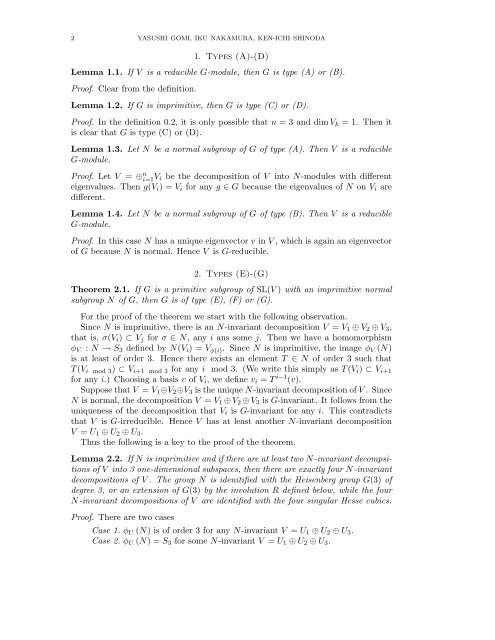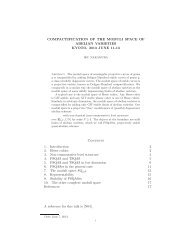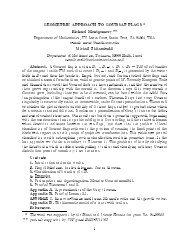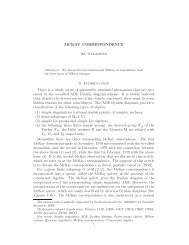A SHORT CLASSIFICATION OF FINITE SUBGROUPS OF SL(3,C) 0 ...
A SHORT CLASSIFICATION OF FINITE SUBGROUPS OF SL(3,C) 0 ...
A SHORT CLASSIFICATION OF FINITE SUBGROUPS OF SL(3,C) 0 ...
- No tags were found...
You also want an ePaper? Increase the reach of your titles
YUMPU automatically turns print PDFs into web optimized ePapers that Google loves.
2 YASUSHI GOMI, IKU NAKAMURA, KEN-ICHI SHINODA1. Types (A)-(D)Lemma 1.1. If V is a reducible G-module, then G is type (A) or (B).Proof. Clear from the definition.Lemma 1.2. If G is imprimitive, then G is type (C) or (D).Proof. In the definition 0.2, it is only possible that n = 3 and dim V k = 1. Then itis clear that G is type (C) or (D).Lemma 1.3. Let N be a normal subgroup of G of type (A). Then V is a reducibleG-module.Proof. Let V = ⊕ n i=1 V i be the decomposition of V into N-modules with differenteigenvalues. Then g(V i )=V i for any g ∈ G because the eigenvalues of N on V i aredifferent.Lemma 1.4. Let N be a normal subgroup of G of type (B). Then V is a reducibleG-module.Proof. In this case N has a unique eigenvector v in V , which is again an eigenvectorof G because N is normal. Hence V is G-reducible.2. Types (E)-(G)Theorem 2.1. If G is a primitive subgroup of <strong>SL</strong>(V ) with an imprimitive normalsubgroup N of G, then G is of type (E), (F) or (G).For the proof of the theorem we start with the following observation.Since N is imprimitive, there is an N-invariant decomposition V = V 1 ⊕ V 2 ⊕ V 3 ,that is, σ(V i ) ⊂ V j for σ ∈ N, anyi ans some j. Then we have a homomorphismφ V·: N → S 3 defined by N(V i )=V φ(i) . Since N is imprimitive, the image φ V·(N)is at least of order 3. Hence there exists an element T ∈ N of order 3 such thatT (V i mod 3 ) ⊂ V i+1 mod 3 for any i mod 3. (We write this simply as T (V i ) ⊂ V i+1for any i.) Choosing a basis v of V i , we define v i = T i−1 (v).Suppose that V = V 1 ⊕V 2 ⊕V 3 is the unique N-invariant decomposition of V . SinceN is normal, the decomposition V = V 1 ⊕ V 2 ⊕ V 3 is G-invariant. It follows from theuniqueness of the decomposition that V i is G-invariant for any i. This contradictsthat V is G-irreducible. Hence V has at least another N-invariant decompositionV = U 1 ⊕ U 2 ⊕ U 3 .Thus the following is a key to the proof of the theorem.Lemma 2.2. If N is imprimitive and if there are at least two N-invariant decompsitionsof V into 3 one-dimensional subspaces, then there are exactly four N-invariantdecompositions of V . The group N is idenitified with the Heisenberg group G(3) ofdegree 3, or an extension of G(3) by the involution R defined below, while the fourN-invariant decompositions of V are identified with the four singular Hesse cubics.Proof. There are two casesCase 1. φ U·(N) is of order 3 for any N-invariant V = U 1 ⊕ U 2 ⊕ U 3 .Case 2. φ U·(N) =S 3 for some N-invariant V = U 1 ⊕ U 2 ⊕ U 3 .





